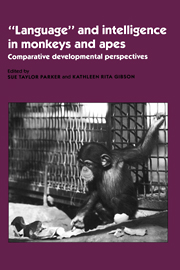Book contents
- Frontmatter
- Contents
- List of contributors
- Foreword
- Preface
- Acknowledgments
- Part I Theoretical frameworks for comparative developmental studies
- Part II Comparative developmental perspectives on cebus intelligence
- Part III Questions regarding imitation, “language,” and cultural transmission in apes and monkeys
- 9 Do monkeys ape?
- 10 Cultural transmission in the tool use and communicatory signaling of chimpanzees?
- 11 Primate cognition: From representation to language
- Part IV Developmental perspectives on social intelligence and communication in great apes
- Part V Development of numerical and classificatory abilities in chimpanzees and other vertebrates
- Part VI Comparative developmental perspectives on ape “language”
- Index
10 - Cultural transmission in the tool use and communicatory signaling of chimpanzees?
Published online by Cambridge University Press: 11 May 2010
- Frontmatter
- Contents
- List of contributors
- Foreword
- Preface
- Acknowledgments
- Part I Theoretical frameworks for comparative developmental studies
- Part II Comparative developmental perspectives on cebus intelligence
- Part III Questions regarding imitation, “language,” and cultural transmission in apes and monkeys
- 9 Do monkeys ape?
- 10 Cultural transmission in the tool use and communicatory signaling of chimpanzees?
- 11 Primate cognition: From representation to language
- Part IV Developmental perspectives on social intelligence and communication in great apes
- Part V Development of numerical and classificatory abilities in chimpanzees and other vertebrates
- Part VI Comparative developmental perspectives on ape “language”
- Index
Summary
One of the most exciting findings to emerge from recent observations of freeranging chimpanzees in equatorial Africa is that different populations behave differently: They eat different foods, use different tools, and communicate in different ways. These differences seem to persist across generations, and their geographical distribution (neighbors often differ more than do populations living a continent apart) makes it unlikely that they are due to genetic factors. Some researchers have therefore taken to speaking of chimpanzee “culture” (e.g., Goodall, 1973, 1986; McGrew, 1983; McGrew & Tutin, 1978; McGrew, Tutin, & Baldwin, 1979; Nishida, 1980; Nishida, Wrangham, Goodall, & Uehara, 1983; Sugiyama, 1985).
It is clear, however, that not all population differences are cultural in origin. Although the term culture is not easy to define, either when applied to human societies (e.g., White, 1959) or when applied to animal populations (e.g., Booner, 1980; Mainardi, 1980; Washburn & Benedict, 1979), at the very least culture would seem to require some form of social learning. Thus, no one would claim cultural transmission if all members of a population learned a particular behavior only because they each had been exposed to the same set of contingencies from the physical environment. For example, naturalistic observations have revealed that one population of wild rats dives into the Po River (in Italy) for mollusks, whereas another population of rats living on that same river does not.
- Type
- Chapter
- Information
- 'Language' and Intelligence in Monkeys and ApesComparative Developmental Perspectives, pp. 274 - 311Publisher: Cambridge University PressPrint publication year: 1990
- 131
- Cited by



